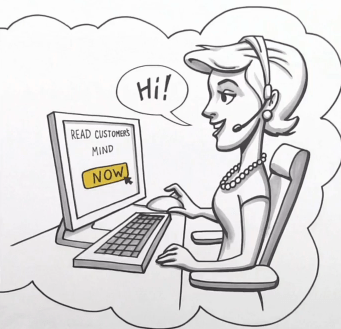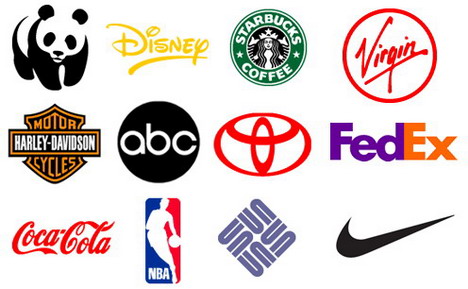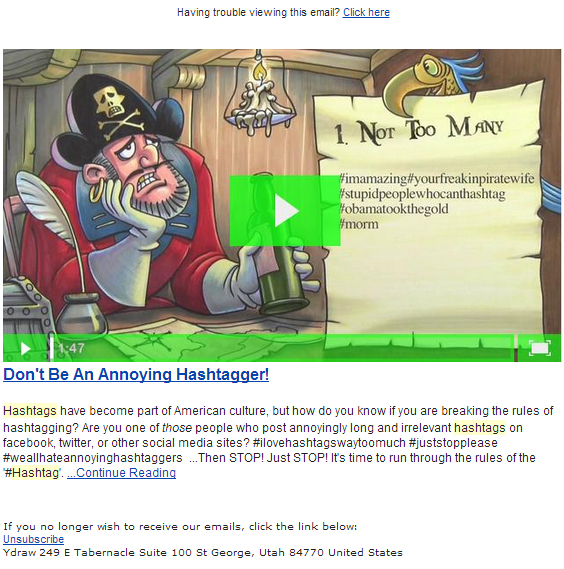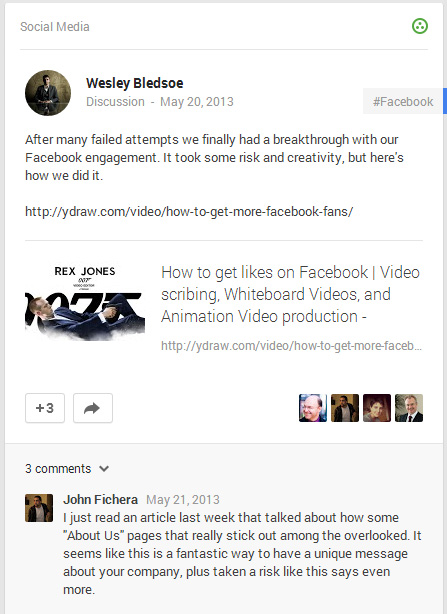
by Ydraw | Nov 20, 2013 | video
Setting Expectations: How You Can Win with Your Customers Every Time
Have you ever had an experience where you were sure the customer was going to love your work, only to find out they were disappointed or downright ticked? It was your best effort, or so you thought, and everything was delivered on time. So how could this happen? Where did you go wrong… or did you?
If you want to achieve success with most any customer, in most any situation, then it really boils down to this – you need to set proper expectations.

Sounds simple enough, by doing this one critical thing you can eliminate frustration, open more effective channels of communication, and have both parties satisfied with the results. Truly! And here’s a little bonus, this does not just apply to business relationships, but can be used to great effect with co-workers, friends, family, spouses… just about anyone with whom you share a relationship of some kind.
So how do you set proper expectations? Here’s how a great mentor once taught me a simple yet very powerful method:
1) Set expectations up front
2) Expectations must be mutually defined and agreed upon
3) If possible, write them down
1. Set expectations up front
Once you’ve let the cat out of the bag, it’s a pretty painful process to get him back in there. Same thing applies with expectations. While my memory isn’t ironclad, I can still remember first impressions, first expectations, first thoughts and feelings of a particular experience or project. Those can certainly change over time, but it typically requires a lot more work to do so. The same generally applies with your customer. Once they have an idea in their head, good luck convincing them to let it go.
You may already be setting expectations with customers and not realize it. How? Your website, your social media sites, your posts and tweets. Be mindful of what you’re “promising” or offering to customers through your various media and properties. Prices, deadlines, guarantees, services all better be 100% realistic or your customers will insist you do it, call you on it if those change, and may even it hold it against you if it doesn’t all add up in the end.
What few companies realize is that this is your “golden” opportunity to help shape the behavior of your customers. If you want your customers to complete a form, submit documents, understand your process, etc, its up to you to set that up in the beginning. It takes a little more focus and deliberate action on your part, but it will pay dividends, big time, now and down the road.
WORD OF CAUTION: If you’re in sales, you’re a big part of setting a customer’s expectations. You’re typically at the front of the process, so whatever you promise, agree to, and reinforce will be etched into the relationship from this point forward. I’m not just talking about price either. The old saying of “under promise, over deliver” is really saying don’t set expectations you can’t meet, deadlines that aren’t realistic or results that can’t be reached. Don’t set the rest of your team up for failure because you did or said “anything” just to get the sale.
2. Expectations should be mutually defined and agreed upon
“What do you want?” “I don’t know, what do you want?” Sound familiar? So here’s a tip. Unless you want a customer asking for the moon, or a 45 minute monologue of the history of their company… don’t ask “what do you want?”. Trust me, there are better ways to define expectations. Here are the 2 best questions I’ve ever heard that help people narrow down their answers to something that makes sense:
What is your best case scenario (for this project, product, experience, etc)?
Ok. Now tell me, what’s your worst case scenario?
Simple, yet incredibly effective. Why? Well, most people can articulate their best case scenario. They really can. It’s also true that most people can tell you their worst case scenario too. What I find fascinating is that often times a customer’s worst case scenario is far better than what I was imagining. But this is good. These two questions help you define the parameters, or the borders of your relationship and possible expectations. Now you can narrow it down even further with this follow up question.
So if this is your best case, and your worst case, would this (say for example ⅔ of the way to best case) be considered success to you?
If your customer answers yes? Bravo! You’ve just set the expectation of what success or victory looks like. If not, offer another possible example as success, or ask them what they consider success.
Here’s why I absolutely love this technique. First, since you’re asking the questions, you’re in control of the conversation. Second, it’s very non-threatening. It’s a comfortable discussion with no wrong answers. Third, it’s mutual. Both parties are involved in defining what the expectations should be. Fourth, it makes you seem very smart, even though it’s incredibly easy to do!
Now that you’ve defined what the expectations for success are, make sure you both agree upon them. I would recommend saying something like, “so we just decided that this (example) means success. Do you agree? Does that work for you?”. The mutual agreement is critical and here’s why. So you can hold each other accountable. If you don’t mutually agree then it’s one party imposing their expectations upon the other, and that rarely works out as intended or in a truly positive way.
3. When possible, write it down!
You’re doing great so far. You’ve set expectations at the right time – up front. You’ve had a great conversation with your customer and mutually defined and agreed what success means. Now you’ve got to write it down. Why? Humans are emotional beings, and to be honest, they change their expectations all the time. What made sense then, seems crazy now. It could be they had a bad breakfast, or got yelled at by the garbage man… who knows. But all those external elements, stresses, and situations can internally affect emotions… and expectations. Throw in the fact that people interpret body language, word meanings, and expressions differently (not to mention may have a faulty memory like mine) and you can see why setting expectations can be tricky if you don’t write it down.
It could be your regular contract with addendums, but it could also be just an email reaffirming what was discussed. But here’s why this step is really important too: What happens when one or both parties don’t meet or exceed the agreed expectations? If it hasn’t been set up front, mutually defined and agreed, and written down – it’s hard to hold either party accountable. But by writing it down and sharing it with the other party, you now know how short, close, or beyond success you’ve achieved. And you know exactly where they stand too!
Ok. So what happens if the expectations don’t work, or need to be adjusted or changed? What happens if one of the parties isn’t happy with the expectations once you get down the road? Don’t worry… it happens… it’s life and things can, and often do, go sideways.
Don’t panic. All you need to do to reset expectations is follow the same process. It will work again. I do, however, like to start by asking, “What changed? What changed to make you unhappy with the previous expectations?” This may give you insights into the other party’s concerns and provide some guidance when resetting, redefining and agreeing to a new set of expectations.
Conclusion. So there you have it. I challenge you to give it a try. It can be anything from a small task to a major project. I’ve had tremendous success for years using this method and technique. Setting expectations is such a critical part of business and personal relationships. Without doing so, it can lead to miscommunication, frustration, and poor results. But, by following the steps of setting expectations up front, mutually defining and agreeing upon them, and writing them down – not only will you know what you have to do to achieve success for your customer, they’ll know it when you claim victory and be right there with you!
+Chris Salisbury
Senior Creative Director
Ydraw

by Ydraw | Sep 30, 2013 | video
Government Shutdown? Your Marketing Shouldn’t!
While our elected officials argue and point fingers, is your message getting to your leads, contacts, and customers?
Unlike Congress, you need to be focused on results, not just making a lot of noise. Can you imagine not having a budget for your company, campaign, or project? You need customers and you need sales, it’s as simple as that. To do that you need your marketing to work for you 24 hours a day, seven days a week and not take extended holidays, costly vacations, or disappear for golf outings every Tuesday.
In today’s online driven world of marketing it’s a numbers game. You need to get in front of as many potential leads as possible, make them listen, entertain them a moment, and most importantly move them to action … for you! To get those numbers, your marketing can’t work like a part time intern. You need workaholics – and I’m not talking about you personally, I’m talking about your marketing materials and content.
How? There are a lot of answers to this question, but here are a few to focus on:
1) Know your customer/audience (or find out… fast)
2) Be where your customers are
3) Keep testing to make sure they like it
1) Know your customer/audience. Sounds easy enough, but have you taken a close look lately at who your customers really are? What keeps them up at night (besides increasing taxes, worthless government programs, and endless debates)? What do they need, and what kinds of questions are they asking to solve their problems? Some of the answers you might be able to pull from past experiences, but there could be some other info right under your nose.
Tip: Go to Ask.com and type in a question or problem your customer typically has. You’ll see a number of questions, related questions, answers and resources all pop up. This is a great snapshot to see what people are asking, what your competition is offering, ideas for your marketing efforts, and how to tailor your message to meet your customers’ needs.
In just a few minutes you can compile some great insights into what’s most important to your customers right now! They might even be asking questions you weren’t aware of, or thought were less important. Just think of how this kind of information can help improve your company’s efforts, and not just in marketing, but in a number of areas.
2) Be where your customers are. If a senator gives a speech and no one is there to listen, did it really happen (and did it really matter)? In political terms it’s often called a filibuster – taking up time, talking about anything or nothing, so the other person can’t speak. You… don’t have that luxury to ramble on. You have a message you need to deliver, and that message needs to reach your target audience.
So… deliver that message where your customers hang out. Again, sounds easy, but it takes a little research to be most effective. How? You need to ask. On web forms, in surveys, even in your everyday sales efforts, make sure you are asking, “How did you find us?
3) Keep testing to make sure they like it. You’re not gonna know what your customer likes without a little testing. And once you have that figured out, you’re going to need to continue to test. Is what they like now the same thing that they liked 5 months ago? Have their tastes changed? Is that same marketing content getting stale to them? Test, test, test…just like high school.
Let us know if you have any questions or comments concerning marketing for us here at Ydraw. As always, we are here to help!

by Jace Vernon | Aug 12, 2013 | Creative Marketing, Marketing
Why Advertising Doesn’t Really Work
Ha! That’s hilarious. Advertising does work. In fact, it works so well that every single person in the entire world – minus the aborigines, the lost tribes and the Gods Must Be Crazy kind of families – has been influenced by some kind of advertising.
If during a moment of weakness while you were cleaning out your inbox, and you happened to read one of the mass emails you so often receive from your dear old granny, you recognize this short story:
A man wakes up in the morning after sleeping on an advertised bed, in advertised pajamas. He will bathe in an advertised tub, wash with advertised soap, shave with an advertised shaver and have advertised juice, cereal and toasted bagel (toasted in an advertised toaster) for breakfast. He’ll then put on advertised clothing and glance at his advertised watch.
He will ride to work in advertised car, call in to let his office know he’s running late from his advertised cell phone, and sit down in an advertised desk chair when he gets to the office. He’ll work at his advertised computer, and write with an advertised pen.
Yet this man hesitates to advertise (or market his business), saying that marketing and advertising don’t work. Finally, when his unadvertised business goes under, he will advertise it for sale.
It’s a funny little story, but it packs a lot of truth – and without further adieu, here are three huge reasons your small business needs to advertise:
Inform Consumers
In a way, advertising saves you money by eliminating sales lost simply because the consumer didn’t have enough knowledge of your product or service. You can use advertising to educate potential buyers so they can comparison shop early. If they come to you having been educated – you know they are there to buy.
Existence by Awareness
If people don’t know about you, then your company is just as profitable as it was when it was only a glimmer of an idea in your eye. Consumers are aware of the companies with the most aggressive advertising campaign. Sure, these companies might get a reputation of being annoying, but at least people will think of them if they ever have a need for car insurance.
Brand Recognition

Aside from Harley Davidson and Starbucks, none of these logos tell you what they represent – yet you already know. Why?
Advertising can seem expensive, especially if you’re in a very competitive market and are scrounging for ways to keep your prices down – however, without advertising, your consumer base will be limited to a few locals, faithful friends, and super supportive relatives. But the truth is that your return on your investment will make having an advertising campaign more than worth it. If you’re not sure where to start, maybe Granny can send out a few mass emails about your company for you? Heaven knows her reach is endless.
+Jessica Anderson
by Jace Vernon | Jul 29, 2013 | Creative Marketing, Explainer Video, video
Video has become one of the effective ways to produce sales leads and increase conversion rates. Many companies will be spending millions on marketing their videos this year, but we wanted to write a post for those companies working on a shoe string budget but still wanting their message to be heard. Once we’ve produced your amazing video, how do you push it out effectively? Here are three steps to marketing your new Ydraw video.
The Day Your Video Launches
1. Email Blast – Email campaigns are one the most effective ways to communicate with your clients and potential customers. We are always looking for new ways to build our email list with genuine leads and find what types of emails convert the best. One way we get high click-through rates is by including a thumbnail of the video and short description of the article.

By linking the article to a blog post or landing page with the video attached, it gives us the opportunity to educate our audience through both video and sales copy. We always include relevant links to previous blog posts and our homepage—the longer you can keep potential customers on your site the quicker you’ll increase your conversions (linking to previous articles also boosts your SEO).
2. Tweet Multiple Times – If you have a following on twitter, tweeting about your video 3 or 4 times the day it launches is a great way to drive traffic. This may sound spammy but because the Twitter community moves so fast, this behavior is acceptable. However not everyone has a huge twitter following, so how can you fix that?
Twitter can be hit or miss for many companies. It is easy to get overlooked by the millions of tweets that are going on all the time. However, if you can find your niche you can drive consistent traffic to your site and create a place to interact with fans of your company. Here is a great way to boost your twitter campaigns:
http://tweepi.com/ – This a site that allows you plug in the twitter URL of leaders in your industry and follow their followers. This a great way to reach out to tweeters who are already interested in your product or service. This tool also allows you to unfollow tweeters who don’t follow you back, this is important because Twitter limits the amount of people you can follow if only a few people follow you back. Tweepi is one of the most effective tools to build a genuine twitter following. This technique takes time, but as you gain a bigger following more people will be willing to follow you back.
Don’t forget to use hashtags in your twitter post. This will increase visibility!
3. Post On Google+ — This social media platform has become a way for business professionals to share their passions. Rather than seeing status updates on what your friends ate for breakfast, people are posting their latest blog post and tips to improve your company. The most effective way to post on Google+ is to use effective hashtags and link your post to a relevant community. If you do some digging you’ll find some communities of like-minded individuals who would benefit from your content and interact with your posts.

Be sure to build out of Google+ profile. Google+ posts are now ranking in Google searches, by filling out your profile you’ll improve your rank.

by Jace Vernon | Jun 17, 2013 | video
What the 2013 Finals are Teaching Us about Marketing
In the season finale of Game of Thrones we learned a crown doesn’t give you power, but an army does. “King James” has played a sizable chunk of these playoffs with a supporting cast that seems disinterested or overwhelmed at times. Dwayne Wade’s fragile knees and Chris Bosh’s determination to shoot threes are poison to the Heat. It didn’t take long for the Spurs to discover that the moment they cage Lebron, the Heat run out of options quickly. If game 5 taught us anything, it’s that if Spurs solid core play well, a boost from the role players will overwhelm the opposition. The Heat rely on James being impossible to stop, while the Spurs have consistent producers they can count on every night. So what has this exciting series taught us about marketing? We have watched two very different teams take turns blowing each other out every other game. It’s time to decide whether your marketing strategy is better off with a flashy Lebron strategy or the old school San Antonio approach.
Let’s break down San Antonio’s strategy. This strategy is great for those companies struggling to keep consistent traffic on their site. Ask yourself – What is the core of your marketing strategy? Are you relying on marketing that lacks consistency? Let’s take a look at the building blocks of the San Antonio Spurs.
Tony Parker, Tim Duncan, and Manu Ginobili make up the core of the Spurs. Their new pieces, Kawhi Leonard and Danny Green, are new additions they’ve added to their strategy. What is your core strategy—this is what brings you consistent conversions. Once you’ve established your core, you can begin adding pieces to your strategy. Although new additions to your strategy can include risk, you can strike gold with these new techniques (Danny Green now holds the title for the most three’s made in a final series) or your risk won’t pay off; that’s okay, because you know your core is coming through.

What should be the core of your marketing?
1. Organic Search (SEO) – It’s hard to beat being in the right place at the right time. No one likes to be sold, but everyone likes to discover something great. Google has created an amazing platform for this. You need to be the gold your target audience finds at the end of their Google search.
2. Paid Search – If done right, PPC can generate traffic instantly. If done wrong, you are better off simply flushing your money down the toilet. Building a great campaign is essential to your success. Get your quality score up and pay attention to it. You need to know exactly where your money is going.
3. Email Marketing- Don’t spam; unless, of course, you are trying to lose your audience as quickly as possible. Learn from the best, Wistia is a great example of a company that sends emails that have personality and include useful information. You will keep your audience if you can provide useful information on a regular basis.
This next technique can be a great tool for companies who are looking to add to their core marketing. This is the Danny Green of your marketing strategy. This is the piece that adds to your core and lifts you above the competition. Video should be a part of every marketing budget. One reason Wistia’s email marketing is so successful is because they include a video in almost every email. The following strategy helps boost your SEO efforts.
Leverage Video for SEO- I never realized the backlink opportunities I was missing out on by posting my videos on YouTube and Vimeo. By posting your video on these sites you do two things: you lose traffic to the next suggested video and eliminate any opportunity for a potential backlink. We discovered a new technique for leveraging video for backlinks. By hosting our videos on Wistia, we give viewers the option to embed the video onto their site. This option is also available on YouTube and Vimeo, but when those videos are embedded the link points back to your profile on those sites. This is beneficial for YouTube, but not you. With some tinkering you can add a backlink into the code of Wistia videos. Every time your video is embedded you will receive a backlink. We’ve had a lot of success stricking deals with customers.
At Ydraw we’ve created Fast and Easy Videos. This new product was built around the idea that companies benefit from producing quality videos to consistently communicate with their audience. Fast and Easy Videos come at a quarter of the price of our other videos and are done in hours, not days.
A detailed post on Leveraging Video for SEO is coming Friday. We’ll give you the step by step guide.
Okay, we have our core; now let’s swing for the fences – Let’s take a Lebron approach – where can we take some risks?
This is a unique way to approach marketing but it can be a perfect approach for certain companies—if a Lebron James is willing to take his talents to your beach.
Partner with Bloggers- in Neil Patel’s latest blog post, he described how he landed 25 thousand hits on a SEO guide he created by linking to Moz (this became his Lebron James). Moz responded with a write up on the guide and the traffic flew in. Patel hit a home run; he now partners with other blogs when he launches new guides. This isn’t a marketing technique that qualifies for the core because it’s hit or miss. A blog has to be willing to advertise your company. You can’t rely on blogs partnering with you every week—they don’t like to give away traffic. However, when you spend the time and money on great content (Neil Patel spent six months on his guide) it can drive traffic for both you and a partnered blog and it can be a massive boost to your company. Then your task becomes giving them a reason to come back.
So, let’s look at the Lebron strategy in a little more detail.
Convincing bloggers to cover your product or service can be a huge boost for your company. In Ryan Holiday’s book, Trust Me, I’m Lying, he breaks down how to leverage bloggers for your marketing efforts. He begins by explaining how bloggers make their money. Some are paid per post and others are paid for traffic. This means a blogger makes the big bucks by constantly producing high quality content that appeals to his/her audience. It also means that an audience won’t stick with a blogger if they feel like they are being sold a product. So, how do you get covered by a popular blogger while keeping their integrity in tact? First things first, keep in mind that they make the big bucks by constantly producing content, so typically they aren’t opposed to a little help if it is going to benefit their readers. Toyota got creative and gave a car to a popular vehicle blogger and told him to write about the car, good or bad. Some companies will naturally draw bloggers to covering them because of new technology or innovation. Other companies may need to nudge a blogger a bit. The first step is to identify popular bloggers in your field. Then approach them with a simple pitch that explains why your message would benefit their readers. If you can pitch your message in the right way and provide enough information that their blog is nearly written for them, they’d be crazy not to consider it.
Discover what approach works best for your company. Are you better off with the slow, methodical San Antonio Spurs approach or will you benefit more from a Lebron James boost. Better yet, find a way to use both.
Tune in next week for a detailed post on leveraging blogs for marketing.
+Wesley Bledsoe








